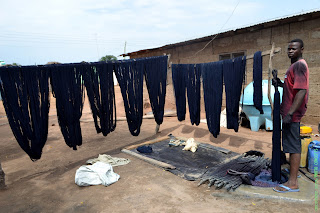NEW DAWN, NEW TAMALE, NEW GHANA. PEACE REIGNS.
Thursday, September 5, 2013
Tuesday, September 3, 2013
PORTABLE WATER IS STILL A PROBLEM IN RURAL COMMUNITIES.
Rural communities in the Northern Region
still struggle to have access to potable drinking water as shown in the
photographs taken at Kpallbisi in the East Gonja District.
The situation of access to safe
water and sanitation in rural Ghana is even more disturbing to see how women
and children in this communities walk for mile and struggle to have access to water.
Speaking to Mr. Salifu Saidu Daari,
the Assemble man for are explained that, the over 1,500 population have no access
to safe drinking water, place of convenience and electricity.
He said, there are limited sources
of water available to provide safe drinking water to the entire population,
where the only source is the surface water which is often highly polluted.
Though the practice is not hygienic,
but we don’t have any option than to do it, he stressed.
Women and young girl spend most of
their time walking miles for their daily water needs.
He also said that, diseases such as
cholera are spread rampantly during the wet season where the young ones are
very vulnerable.
The assemblyman then pleaded for the
Government and other philanthropist to come to the aid of the community.
Tuesday, August 27, 2013
PHOTOGRAPHY FOR PEACE IN GHANA
I GEOFFREY BUTA, A PHOTOJOURNALIST IN THE NORTHERN REGION (TAMALE) PLEDGE FOR PEACE FOR CHILDREN, PEACE FOR WOMEN AND PEACE GHANA.
During and after the Supreme Court's ruling on the 2012 election petition
A US MILITARY OFFICER IN A HAPPY MOMENT WITH KIDS IN THE NORTHERN REGION OF GHANA.
THE NORTHERN REGIONAL MINISTER BEDE ZIEDING WITH INSCRIPTION BEHIND HIM ON A CAR WRITTEN " AFRICAN CHILD"
Thursday, July 25, 2013
HOW QUALITY IS OUR EDUCATION.
This modern day, some students still struggle to have access to better education. The photographs show how some students at the Jakara Yilli S.D.A Junior High School in the Tamale Metropolis write their end of term exams on building blocks, bench and bicycles.
Monday, June 24, 2013
ABJECT POVERTY STILL IN RURAL GHANA.
These photographs taken in
Chereponi in the Northern Region of Ghana shows children and a mother (standing)
competing with pigs and dogs for groundnuts on a small refuse dump after
winnowing.
Chereponi is among seventeen
districts in the Northern Region benefiting from United State Agency for
International Development (USAID) funded project on Resiliency in Northern
Ghana Project (RING) to contribute to the government efforts to sustainably
reduce poverty and improve the nutritional status of vulnerable households in
targeted communities in the Northern Ghana, but one may wonder if this
vulnerable children are benefiting from the project.
A research conducted by the
World Food Programme on their comprehensive food security and vulnerability
analysis on the Northern Region identifies significant disparity in
development.
Despite an overall increase
in Ghana’s wealth and development in recent years, the Northern Region
continues to record high incidences of poverty, food insecurity and
malnutrition.
Although the Government has
made great strides in helping people get out of various health hazard and
abject poverty with the help of other Non-Governmental Organization but much
more need to be done to alleviate health risk and abject poverty in the rural
communities especially in Northern Ghana.
Photos: Geoffrey Buta.
Tuesday, June 11, 2013
IMPACT OF POVERTY AND EDUCATION IN RURAL COMMUNITIES.
Some female school children.
Story/Photos: Geoffrey Buta.
Female children currently attending
school in rural communities are far more likely not learning the critical
skills, such as reading, writing and math. While this gender, income and learning
gaps exist in most rural communities especially in Northern Ghana.
Considering the significance of rural
poverty across the country, it should come as no surprise that rural
schoolchildren are the most disadvantaged from a socioeconomic perspective when
it comes to access to a quality education.
A research shows that, most school
going age children in rural communities drop out from school to find greener
pasture in the Southern part of the country.
Photographs taken during a visit to
Gbandu a village in East Mamprusi district and Dakpemyili in the East Gonja
District all in the Northern Region reveal the significant challenging’s school
children in this rural communities encounter.
The schools lack infrastructures,
computer lab, library, and portable drinking water and toilet facilities.
Most of the challenging’s in the rural
schools generally have less qualified teachers and not enough teachers for the
number of children enrolled in school.
The reasons for these low numbers in
rural communities are many and very much linked to poverty and other
inequalities and socioeconomic conditions.
Teachers generally prefer urban to
rural schools because urban areas offer greater opportunities and higher
incomes. There is also a better quality of life in urban areas, with better access
to good infrastructure, healthcare and general public goods.
Northern Ghana is characterized by
poor or nonexistent infrastructure and little or no provisions for other
critical social services especially in the rural communities.
This in turn negatively impacts the
quality of education for rural-area children since even getting to school is a
more difficult challenge and illness of a pupil or a family member may force
the pupil to drop out of school entirely.
Students in this sector are further
disadvantaged by the fact that their parents are generally uneducated.
Speaking to Mr. Alhassan Abdulai
Iddi, the Executive Director of Net Organization for Youth Empowerment
and Development (NOYED) Ghana, a Non-Governmental Organization said, despite the effort of NGO’s to assist in addressing this
worrying situation of rural education crisis,
the government through the assemblies must implement policies that will reduce
poverty in rural areas.
Such policies must address better
educational facilities, health, sanitation conditions, and modernizing the
agricultural sector for parents to grow more to take care of their wards as
this is their only source of income, he said.
According to Mr. Iddi, the long-term
consequences of continued poverty and socioeconomic inequalities in rural areas
should not be underestimated.
He said, the conditions will only
continue to exacerbate the education and learning gaps between rural and urban
school children if appropriate steps are not taken to address the situation.
Poor quality education in rural
areas will only continue to perpetuate long-term poverty in the region, he added.
Is the country on course of
achieving Millennium Development Goals on Universal Primary Education?
some children riding donkey in Chereponi district in the Northern Region.
some school children carrying fire food to school.
Monday, June 3, 2013
Daboya “Traditional SMOCK weaving heritage” in Ghana.
Daboya is the district capital of
North Gonja, which is about 60 km west of Tamale via the Nyankpala/Tolon road.
It is one of the most unique craft
villages in West Africa which holds a special place in the traditional textile
industry of Ghana.
It is a town known for its special traditional smock (fugu) weaving involving the various stages of the process locally made to its
finest stage.
The majority of about 20,000 are
mostly into smock weaving with about 46 communities’ surroundings.
President John Dramani Mahama (r) in a smoke with other. A man soaking the tread.
dying process
some men seriously weaving
The smock weaving industry has been facing a lot of challenging, but the government have ensured its support of investing and promoting the industry.
The United Nations Industrial Development Organization (UNIDO) is leading the formulation of ideas that would come out with a
blue print on a craft center to be established for all smock weavers from
Daboya, Yendi and Tamale.
So far in the history of our nation, Daboya is the
only town which produces the original and best Smock (Fugu).
Photos: Geoffrey Buta
Subscribe to:
Posts (Atom)





















